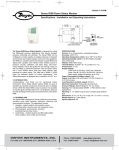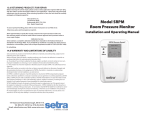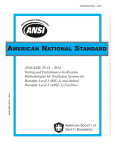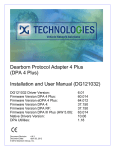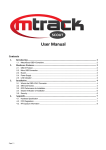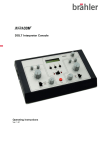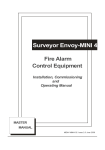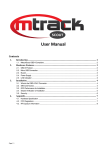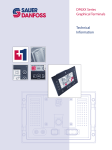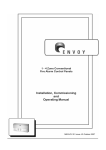Download LIN Fiber Optic Bridge User Manual – Version 2.0
Transcript
LIN FIBER OPTIC BRIDGE USER MANUAL (Satellite Module and Bridge Adapter) Version 2.0 © 2008 Dearborn Group Inc. 27007 Hills Tech Court Farmington Hills, MI 48331 Phone: (248) 488-2080, FAX: (248) 488-2082 http://www.dgtech.com This document is copyrighted by the Dearborn Group Inc. Permission is granted to copy any or all portions of this manual, provided that such copies are for use with the product provided by the Dearborn Group, and that either the name(s) “Dearborn Group Inc.”, and/or Dearborn Group Technology” is retained on all copies as on the original. IMPORTANT NOTICE It is essential that you read this document carefully before using the Fiber-Optic products. Damage caused by misuse of this product is not covered by the seller’s product warranty. When using this manual, please remember the following: • This manual may be changed, in whole or in part, with or without notice. • Dearborn Group Inc. assumes no responsibility for any damage resulting from any accident – or for any other reason – while the Fiber-Optic products are in use. • Specifications presented herein are for illustration purposes only and do not necessarily represent the latest revisions of hardware. Dearborn Group Inc. assumes no responsibility for any intellectual property claims that may result from use of this material. • No license is granted – by implication or otherwise – for any patents or any other rights of Dearborn Group Inc., or of any third party. GRYPHON® is a registered trademark of Dearborn Group Inc. All other products referenced in this manual are trademarks of their respective manufacturers. User Manual Version 2.0 LIN Fiber Optic Bridge – © 2008 2 Table of Contents 1 PRODUCT OVERVIEW / GETTING STARTED.........................5 1.1 Fiber-Optic Bridge Functions / Features ............................................ 5 1.2 Typical usage of a LIN Fiber Optic Bridge .......................................... 6 1.3 Package contents.............................................................................. 7 1.4 Technical support ............................................................................ 7 1.5 Related documents........................................................................... 7 1.6 LIN FO Satellite Module EMC compliance........................................... 8 FIBER OPTIC BRIDGE ADAPTER .........................................9 2 2.1 Power switch ................................................................................. 10 2.2 Power jack ..................................................................................... 10 2.3 DB 9 connector .............................................................................. 11 2.4 Fiber Optical connectors................................................................. 11 2.5 LED indicators for configuration ..................................................... 12 2.6 Configuring DIP switches for the Host (system-copper side)............. 12 2.7 Configuring DIP switches for the Satellite (system-fiber optic side) ... 13 FIBER OPTIC SATELLITE MODULE .....................................15 3 3.1 Power Switch ................................................................................. 15 3.1.1 3.1.2 Power to Satellite Module ................................................................................16 Battery compartment ......................................................................................16 3.2 DB 15 Connector ............................................................................ 16 3.3 Optical Connectors......................................................................... 17 3.3.1 3.3.2 3.4 Fiber Optic and Copper wire connections linking the LIN Bridge to the DUT .......18 Fiber Optic connections ..................................................................................18 Synchronization and Slew Rate indicators for Satellite Module ......... 18 User Manual Version 2.0 LIN Fiber Optic Bridge – © 2008 3 3.5 Configuration and Battery Low indicators for Satellite Module .............. 18 APPENDIX A - FIBER OPTIC BRIDGE PIN ASSIGNMENTS .............20 User Manual Version 2.0 LIN Fiber Optic Bridge – © 2008 4 1 Product Overview / Getting Started Dearborn Group supports several interfaces for use in an EMC test environment. These products, using fiber-optic cabling, provide vehicle network connectivity to device(s) under test (DUT). The Fiber Optic Bridge Local Interconnect Network (LIN) System [Part number: DG-FOBRIDGE-L] consists of two major components: • A Fiber-Optic Bridge Adapter (The component connected to a Tester outside of an EMC chamber) • A Fiber-Optic Satellite Module (The component inside the EMC chamber connected to the device under test) 1.1 Fiber-Optic Bridge Functions / Features The Bridge Adapter works as a pass-through hardware device. It translates the vehicle network electrical signals from a user’s host test device (such as the GRYPHON® tool) into fiberoptic signals. These fiber-optic signals are used to interface with the Satellite Module placed in the EMC Test Chamber. The fiber-optic signals are then translated back into vehicle network electrical signals by the Satellite Module and used to communicate with the DUT. Hardware features of the Satellite Module • • • • • • Anodized aluminum enclosure Anteroom with feed through capacitors SMA Fiber-Optic connectors Indicators for slew rate and configuration Powered via two internal nine-volt batteries Low battery status indicator Hardware dimensions of the Satellite Module Housing: Height: Width: Depth: 1” 6” 2.3” User Manual Version 2.0 LIN Fiber Optic Bridge – © 2008 5 1.2 Typical usage of a LIN Fiber Optic Bridge EMI/EMC Test Chamber FiberOptic cables Cable Cable Cable Cable Cable Cable DG FiberOptic Bridge Adapter F-O LIN SAT MOD DB15 Customer wiring Copper wire Customer Tester DUT LIN Bus = Pin 8 VBat(+) = Pin 4 GND = Pin 5 Copper connection (DB9) output to external tester LIN Bus = Pin 6 GND = Pin 5 Figure 1: Typical Setup for a Fiber Optic Bridge ATTENTION! NOTE: The need for Fiber Optic Satellite Module Isolation The FO SAT Modules need to be isolated by 50mm. This applies to all satellite modules and is not specific to DG’s. The reason is the bypass capacitors typically are placed inside the fiber optic satellite modules from inputs to the Printed Circuit Board/Chassis. If the case of the fiber optic module is placed directly on the ground plane and there are bypass caps inside the satellite module from input to chassis, then there is an additional RF path provided to travel. This path can cause different behavior, and is what is being avoided by isolating the fiber optic module by 50mm insulation above the ground plane. User Manual Version 2.0 LIN Fiber Optic Bridge – © 2008 6 1.3 Package contents The Fiber-Optic Satellite Module package includes the following items: • • • • LIN Fiber-Optic Bridge, including a 12 VDC Universal A/C power adapter LIN Fiber-Optic Satellite Module (nine-volt batteries not included) Three fiber optic cables with SMA connectors (10 meters in length) CD with the user Manual for the Fiber Optic Bridge If you discover that you are missing any part of this package, please contact your Dearborn Group sales representative or the technical support hotline at once. 1.4 Technical support In the U.S., technical support representatives are available to answer your questions between 9 a.m. and 5 p.m. Eastern Time. You may also fax or e-mail your questions to us. Please include your voice telephone number, for prompt assistance. Phone: (248) 488-2080 Fax: (248) 488-2082 E-mail: [email protected] Web site: http://www.dgtech.com 1.5 Related documents Document Version LIN Specification Package Revision 2.0 User Manual Version 2.0 LIN Fiber Optic Bridge – © 2008 7 1.6 LIN FO Satellite Module EMC compliance The LIN Fiber Optic satellite module has been independently tested to the GMW 3097 Feb. 2004 – REV 4 EMC specification. The following test methods were tested without any non-compliances: 3.3.1 Radiated Emissions; Absorber Lined Shielded Enclosure (ALSE). 3.4.1 Radiated Immunity; Bulk Current Injection 3.4.3 Radiated Immunity; Reverberation Chamber, Mode Tuning IMPORTANT! Please read the following before using the fiber-optic Product. User Manual Version 2.0 LIN Fiber Optic Bridge – © 2008 8 2 Fiber Optic Bridge Adapter Figure 2 that follows depicts the front label of the LIN Fiber Optic Bridge Adapter. Figure 2: Front label for the LIN Fiber Optic Bridge Adapter Attention: When connecting the fiber optic cables, always connect Cable 1 of the Bridge to Cable 1 of the Satellite, and likewise Cable 2 to Cable 2 and Cable 3 to Cable 3. (Please see Figure 3 on page 15 for a view of the label for the Satellite Module.) Reference note: Older labels for the Satellite Module and Bridge identified the cables as “Rx, Tx and Cmd” vs. “Cable 1, 2 and 3.” This resulted in some confusion regarding the proper connections between the two units and therefore, the designations were changed to Cable 1, Cable 2, and Cable 3 on the latest Satellite Module, and FO Cable 1, FO Cable 2, and FO Cable 3 on the Bridge Adapter. User Manual Version 2.0 LIN Fiber Optic Bridge – © 2008 9 2.1 Power switch This switch is used to apply/disconnect power to the LIN Fiber Optic Bridge. Power to the unit is applied when the switch is placed in the “up” position. Please note that any change in the Configuration Dip switches will require a Power Cycling (Turn Power Switch OFF and then On) of the Fiber-Optic Bridge Adapter. 2.2 Power jack This standard 2.5 mm connector (with positive center pin) is used to provide power to the LIN Fiber Optic Bridge. This power jack is designed to accept an input range between 8 to 18 VDC. The typical operating voltage supplied by the included Universal Power Adapter is approximately 12 VDC. ATTENTION! FUSE FAILURE: If the Bridge adapter appears dead, check the fuse to see if it has opened the circuit. It is located on the top circuit board in a fuse socket near the ON/OFF switch. The fuse in the bridge is a commonly available type. Littlefuse sells the product under the 'Nanofuse' name. The fuse in the bridge is a slow-blow 1.5A fuse; Digikey part number F2601. Other companies also sell compatible fuses. User Manual Version 2.0 LIN Fiber Optic Bridge – © 2008 10 2.3 DB 9 connector This connector is used to connect the host controller to the LIN Fiber Optic Bridge. Table 1 below provides the pin assignments for the DB 9 (male) connector on the LIN Bridge Adapter that connects to the host test device. LIN Protocol Bridge Adapter DB 9 Connector (male) Pin Number Function Remarks 5 Ground Connect to Ground of Host 6 LIN Bus Connect to LIN Bus of Host All other pins N/A Make no connection to these pins. Table 1: Pin Assignments for LIN Bridge Adapter for connections to Host 2.4 Fiber Optical connectors These three connectors are used to connect the LIN Fiber Optic Bridge to the LIN Fiber Optic Satellite Module, using the supplied 10-meter length fiber optic cables. Note: To ensure reliable data transmission, the length of each cable used should not exceed 100 meters. Reminder note: When connecting the cables between the Bridge and Satellite Module, always connect Cable 1 to Cable 1, Cable 2 to Cable 2 and Cable 3 to Cable 3. (See Figures 2 and 3 for a view of the labels for the respective units.) User Manual Version 2.0 LIN Fiber Optic Bridge – © 2008 11 2.5 LED indicators for configuration The LIN Fiber Optic Bridge has four LEDs that indicate the system status and configuration. See Table 2 (below) for a description of these indications. Green Fiber Optic Side (DUT) LED Color Red Off LED Position LED # 1 LED # 2 Master pull up resistor IN Slew rate – Fast LED Meaning Master pull up resistor OUT Slew rate – Slow Battery Low Slew rate – Normal LED Position LED # 3 LED # 4 Copper Wire Side (Host) LED Meaning Slew rate – Fast Slew rate – Slow Master pull up resistor IN Master pull up resistor OUT Slew rate – Normal Battery Low Table 2: Fiber Optic Bridge – LED Indications 2.6 Configuring DIP switches for the Host (system-copper side) This DIP switch bank is used to configure the ‘copper’ side of the LIN Bus. There are three slide switches: the up position is “on” and down position is “off.” This switch bank is located on the right end of the Bridge (while viewing the product label normally). See Table 3 (below) for the DIP switch options. Note: The default setting is for all three switches to be in the “off” position when the product is shipped. DIP Switch Selections (copper wire side) Functional Configuration for Host Slew rate - Slow Slew rate - Fast Slew rate - Normal Master pull up resistor – switched IN Master pull up resistor – switched OUT Switch 1 Off On X X X Switch 2 Off On X X X Switch 3 Off On X X Table 3: DIP Switch Selections – Host User Manual Version 2.0 LIN Fiber Optic Bridge – © 2008 12 Important: If the DIP switches are changed, power must be recycled on the LIN Fiber-Optic Bridge to enable the changes. The LEDs will flash for several seconds and then stabilize to the selected mode of operation (as shown by the color state of each LED). 2.7 Configuring DIP switches for the Satellite (system-fiber optic side) This DIP switch bank is used to configure the ‘fiber-optic’ side of the LIN Bus. There are three slide switches: the up position is “on” and down position is “off.” This switch bank is located on the left end of the Bridge (while viewing the product label normally). See Table 4 (below) for the DIP switch options. Note: The default setting is for all three switches to be in the “off” position when the product is shipped. DIP Switch Selections (fiber optic side) Functional Configuration for DUT Slew rate - Slow Slew rate - Fast Slew rate - Normal Master pull up resistor – switched IN Master pull up resistor – switched OUT Switch 1 Off On X X X Switch 2 Off On X X X Switch 3 Off On X X Table 4: DIP Switch Selections – Satellite Note: The Master pull up resistor is switched IN or OUT depending upon the need for the DUT to have this load included, e.g., a “slave” DUT may need this load switched “IN” while a “master” DUT may not. CAUTION! Switching this load resistor “IN” when not needed could result in a reduction of battery life for the Satellite Module. Remember: If the DIP switches are changed, power must be recycled on the LIN FiberOptic Bridge to enable the changes. The LEDs will flash for several seconds and then stabilize to the selected mode of operation (as shown by the color state of each LED). User Manual Version 2.0 LIN Fiber Optic Bridge – © 2008 13 Note: Changes made to the left side DIP switches control the configuration of the LIN FiberOptic Satellite Module. This feature allows you to change the configuration without having to enter the test chamber. The changes are transmitted to the Satellite Module via the fiberoptic communications channel (Cable 3). User Manual Version 2.0 LIN Fiber Optic Bridge – © 2008 14 3 Fiber Optic Satellite Module The LIN Fiber-Optic Satellite Module is normally placed inside of the test chamber, although it is often used for tests performed outside the chamber as well. Figure 3 that follows depicts the label for the LIN Fiber Optic Satellite Module. Figure 3: LIN Fiber Optic Satellite Module ATTENTION! NOTE: The need for Fiber Optic Satellite Module Isolation The FO SAT Modules need to be isolated by 50mm. This applies to all satellite modules and is not specific to DG’s. The reason is the bypass capacitors typically are placed inside the fiber optic satellite modules from inputs to the Printed Circuit Board/Chassis. If the case of the fiber optic module is placed directly on the ground plane and there are bypass caps inside the satellite module from input to chassis, then there is an additional RF path provided to travel. This path can cause different behavior, and is what is being avoided by isolating the fiber optic module by 50mm insulation above the ground plane. 3.1 Power Switch This switch (marked I/O PWR on the label above it) is used to turn power on or off to the LIN Satellite Module. Power is applied to the unit when the switch is moved to the left (I), and power off to the right (O). User Manual Version 2.0 LIN Fiber Optic Bridge – © 2008 15 3.1.1 Power to Satellite Module Power is supplied to the Fiber Optic Satellite Module via two internal nine-volt batteries and may be turned on or off via the toggle switch (see Section 3.1 above). 3.1.2 Battery compartment The Fiber Optic Satellite Module is powered by two nine-volt batteries inserted into the battery compartment and connected as indicated on the label of the module. 3.2 DB 15 Connector This connector is used to connect the LIN Fiber Optic Satellite Module to the DUT (Device Under Test). Table 5 provides the DB 15 (H D female) connector pin assignments used to connect the Satellite Module to the DUT. The purpose of the VBAT connection between the DUT and the Satellite Module is to power the LIN transceivers residing in the Satellite Module. This is necessary in order to conserve battery power from the nine volt batteries (enclosed in the Satellite Module) that power the fiber optic isolation for the communications necessary for the testing process. ATTENTION! The DUT cannot be powered from the LIN Satellite Module. Important: All three connections (indicated in Table 5 - below) must be made between the Satellite Module and the DUT. Caution: Making a connection to any of the other pins of the DB 15 connector could result in damage to the equipment. User Manual Version 2.0 LIN Fiber Optic Bridge – © 2008 16 LIN Protocol Satellite Module DB 15 Connector (high density female) Pin Number Function BAT Remarks 4 V (+) Connect to VBAT (+) of DUT 5 Ground Connect to Ground of DUT 8 LIN Bus Connect to LIN Bus of DUT All other pins N/A Make no connection to these pins. Table 5: LIN Satellite Module Pin Assignments for Connections to DUT CAUTION! Make only the connections to the DB 15 and DB 9 connectors as indicated in Tables 1 and 5 above. Other pins contain signals and voltages and any connection made to them could cause damage to the hardware. 3.3 Optical Connectors These SMA connectors are used to connect the LIN Fiber Optic Satellite Module to the LIN Fiber Optic Bridge, using the supplied optic cables (each 10 meters in length). NOTE: To ensure reliable data transmission, the length of each fiber optic cable used should not exceed 100 meters. User Manual Version 2.0 LIN Fiber Optic Bridge – © 2008 17 3.3.1 Fiber Optic and Copper wire connections linking the LIN Bridge to the DUT See Table 6 for the fiber optic connections between the Bridge Adapter and the Satellite Module and for the copper wire connections between the Satellite Module and the DUT. Fiber Optic Cables – Bridge to Satellite DB 15 Satellite Connector to DUT (wired) Connect Cable 1 to Cable 1 Pin 4 : VBAT (+) Connect Cable 2 to Cable 2 Pin 5: Ground Connect Cable 3 to Cable 3 Pin 8: LIN Bus Table 6: Fiber Optic and Copper Connections to Satellite Module 3.3.2 Fiber Optic connections The fiber-optic cable needed for connecting the units is a 100/140 Micro multimode fiber optic cable with SMA connectors. Please see Figure 2 as a reference in connecting the fiber optic cables. 3.4 Synchronization and Slew Rate indicators for Satellite Module This status LED (closest to the power switch) will flash for approximately 1-2 seconds at power up as synchronization occurs between the Satellite Module and Bridge Adaptor. Thereafter, this LED will provide the user information regarding the selected slew rate, wherein: red = slow, green = fast and off (unlighted) = normal. Note: The default slew rate is “normal” and is the most commonly used. Please note that not all LIN transceiver Integrated Circuits support the “fast” slew rate. 3.5 Configuration and Battery Low indicators for Satellite Module This status LED (farthest from the power switch) also serves as a multifunction indicator. Red indicates the unit is functioning in a “Slave” mode, while green indicates “Master” mode. User Manual Version 2.0 LIN Fiber Optic Bridge – © 2008 18 During operation this LED will always be illuminated (either red or green) unless there is a low battery condition, in which case the LED will be turned off. When this LED is no longer illuminated (i.e., turned off), it indicates that the enclosed batteries are not providing sufficient power for the proper operation of the module and the batteries should be replaced. Important: Do not attempt to run further tests until the batteries have been replaced. User Manual Version 2.0 LIN Fiber Optic Bridge – © 2008 19 APPENDIX A - Fiber Optic Bridge Pin Assignments [FO Bridge Adapters and supported FO Satellite Modules] NOTE: Fiber-Optic Bridge (Released Version FY 2007 and later) Pin Assignments (Voltage supplied by Power Adapter Connector): Protocol Protocol T CAN G J1850 VPW (Class 2) K KWP2000 L Pins Used Pin 2: CAN Low Pin 7: CAN High Pin 3: 1850 Bus Pin 5: Ground Pin 1: K Line Pin 5: Ground Pin 5: Ground Pin 6: LIN Bus LIN NOTE: This is a DB-9 Male connector. Only connect these pins when powered from the Bridge Adapter’s Power Adapter Connector). Fiber-Optic Satellite Module (Used with the Fiber Optic Bridge) Pin Assignments: Module Protocol T CAN G J1850 VPW (Class 2) K KWP2000 L LIN Pins Used Pin 6: CAN High Pin 14: CAN Low Pin 2: J1850 Bus Pin 5: Ground Pin 5: Ground Pin 7: K Pin 4: VBAT + Pin 5: Ground Pin 8: LIN Bus NOTE: This is a High Density DB-15 Female connector. Only connect these pins when powered from the Bridge Adapter’s Power Adapter Connector). User Manual Version 2.0 LIN Fiber Optic Bridge – © 2008 20





















